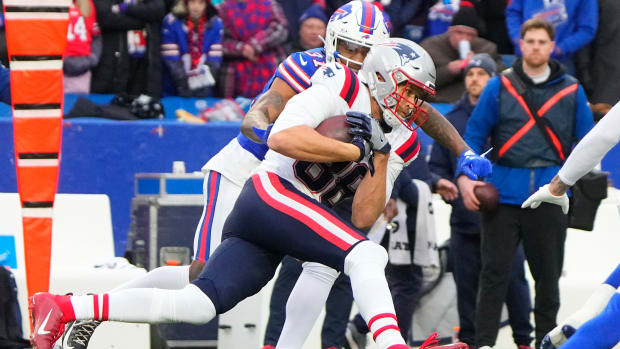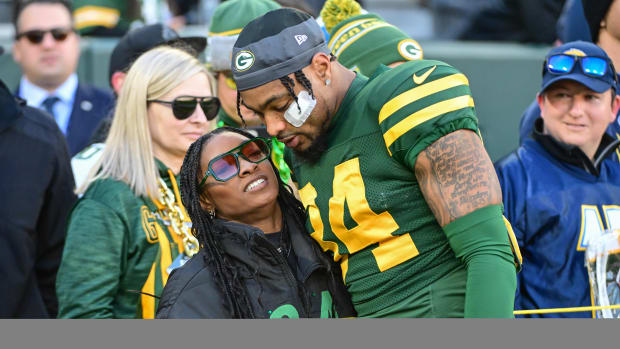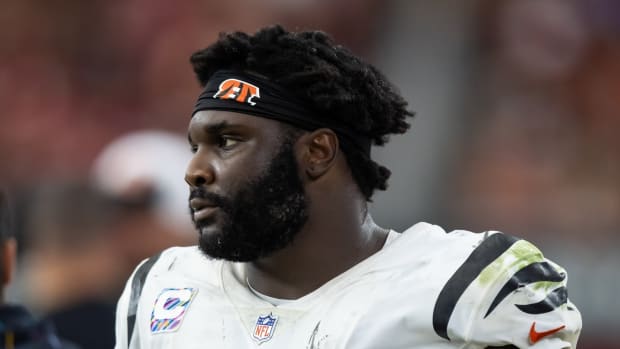Business of Football: Packers’ Stock, the Rams’ Experiment and Thanksgiving Memories
We’ve reached Thanksgiving week, and, as always, the Business of Football has more than enough stories impacting the league both on and off the field.
Packers’ “stock” perspective
The Packers held a stock sale last week, selling off 300,000 “shares”—for $300 each—that have no transferrable value, pay no dividend and entitle the purchaser to no say in team decisions. I did not experience a stock sale in my decade with the Packers, as there was one before and one after my time, and I am not an “owner,” although I did purchase shares for my sons, for $250 each, in the previous sale.
I have written before in this space about the unique structure of the Packers. We, of course, had no owner. We had a board of directors that met quarterly and an executive committee that met monthly. And, of course, we had tens of thousands of shareholder “owners.” But as to the power of any of these groups, all I knew was that I had great autonomy in doing my job, autonomy that I appreciated but took seriously. The board of directors, the executive committee and the president all showed great deference to football operations; their roles were much more on the administrative and business side. Sometimes I missed having an owner, especially in dealings with the league office, but for the vast majority of the time, I did not envy my colleagues at other teams’ reporting to owners. My owners were quite friendly.
Speaking of which, there is a strong divergence of opinion about these sales between non-Packers fans and Packers fans. Non-fans wonder why someone would pay $300 for a piece of paper; they say it is a ruse the team foists on its duped fans. I’ve heard that often, but here’s the thing: Those people just don’t get what I lived for a decade and continue to see every day on all my channels. Packers Nation is just different; Packers fans are a special breed.
There is no professional sports community in this country that wraps itself around a team like the Packers fan community. When I moved to Green Bay and started looking for a home, I was amazed: Most of the houses we looked at had some sort of Packers “shrine room,” adorned with green carpeting—or flooring or wallpaper or paint—as well as team memorabilia and, of course, their framed stock certificate. And to many Packers fans, that stock certificate is the most valuable thing they own.
As for whether fans are actually making a donation or gift to the Packers: Of course they are, and they know it. I do find it interesting, though, that there is not the same derision about states and municipalities “donating” or “gifting” hundreds of millions of fan-supported taxpayer funding to assist billionaire NFL owners in stadium construction. For perspective, the Packers’ $90 million raised in this process is dwarfed by Nevada’s recently “donating” $800 million to the Raiders for stadium funding.
Are the Packers taking advantage of the most loyal fan base in the NFL, and one spoiled by 30 years of franchise quarterback play? Of course they are, but every NFL team would do if it they could.
Let this sink in: A frigid little burgh of 100,000 people in north-central Wisconsin has an NFL team, and one with sustained success. Although their ability to financially compete is primarily due to equally shared NFL media revenues and the leveling effect of the salary cap, the stock sale also helps ensure that viability. The Green Bay Packers’ story is still the one of the greatest in American sports.
The Rams’ great experiment
Last week the Rams made news (again) in a year when news seems to find them. While they face damaging litigation off the field in their old home of St. Louis that could result in a judgment against them in the billions, they continue what I call “the great experiment” on the field.
Odell Beckham Jr. had his choice of teams—according to reports some of the teams interested were the Packers, Chiefs and Saints—but chose the Rams for the modest amount of $1.2 million plus incentives. A couple of thoughts on the player and the team: Beckham is, to me, more name than game, more celebrity than elite player, more star than difference-making receiver. The Browns, who surrendered a first-round pick and a starting safety to acquire him a few years ago, chose to move on and could not even muster a low-round pick for him before putting him on the waiver wire, where he went unclaimed. Some have excused teams here as not having the cap room to sign him. As I know so well, having managed a cap for 10 years, that is nonsense: If a team really wants a player, it is not going to use cap or cash as an excuse. Teams that do that are just not really into the player.
As for the Rams, they are “all in,” “win now,” or whatever cliché you’d like to use. Personally, I subscribe to a more conservative team-building strategy, with an eye to the future along with the present. If “all in” doesn’t work, “all out” will not be pretty. The Rams have scoffed at dead money—cap accounting for players no longer on the roster—as they have had two of the three highest dead-money charges in NFL history, those of Brandin Cooks and Jared Goff. And, as we know, the Rams have no use for top draft picks, as they will spend the next draft weekend staring longingly at pictures of Matthew Stafford and Von Miller.
Having talked to a few team executives, I know other teams—as well as league officials—are definitely watching. The Rams are running a great experiment in roster and cap management for which we can all weigh the results at the end of the year.
Tight end too high
I watched the Falcons for the first time last week on Thursday Night Football—I now co-stream the games for Amazon on Twitch—and noted Kyle Pitts, the Falcons’ gifted tight end who was the fourth pick and the first non-quarterback selected in last year’s draft.
I said this about Saquon Barkley a few years ago when he was the second pick to the Giants, and I will say this about Pitts: He may be the rookie of the year (Barkley was), but it will still not be a good-value pick.
The Pitts pick will haunt the Falcons for years, and it will have nothing to do with how good Pitts is. Pitts may be a generational tight end, but will be a tight end. In my opinion, you don’t draft a tight end fourth overall, no matter the talent; you just don’t. And of course, no one has, with the highest previous pick used on that position being on Mike Ditka … in 1961!
Matt Ryan has been a wonderful NFL quarterback, but he is on the downside of his career with a declining team, and there appears to be no succession plan, whereas they could have drafted Justin Fields or Mac Jones instead of Pitts. Fields or Jones may have sat a year or two behind Ryan, but they would have been set up for the future.
As I always say (with my Green Bay background): The worst time to find a quarterback is when you need a quarterback.
Taysom Treasure
This summer, I inducted my inaugural class of the Business of Football Hall of Fame. Since that time, a few names have emerged for consideration, with one popping up again this week. Taysom Hill, the Saints’ backup quarterback/running back/tight, has had some eye-popping contracts this year. Much of it has been and will be phony numbers to either play games with the salary cap or allow his agent to puff the contract to the media. But even without the phony parts of the deal, Hill may still be a potential Hall of Famer depending, of course, on what you think of him as a player.
In March, Hill signed a deal worth, and this was not a joke: $140 million for four years. In truth, it was a one-year deal worth $12 million; phony years were added for cap proration (they could have picked the number $140 billion) and the deal was to void at the end of this season. Now the Saints needed to do another deal to avoid a huge dead-money charge upon the void (the unamortized bonus from the phony years would accelerate). They gave Hill a somewhat creative contract—paying him considerably more if he plays the requisite number of quarterback snaps to be considered a quarterback (which won't happen). It’s a four-year deal with a reported total value of $95 million that will—in reality—probably end up paying him around $25 to $30 million.
If the higher numbers on these contracts—$140 million and $95 million—were real numbers, Hill would have a Sam Bradford–like bust in the Business of Football Hall of Fame. Even the real numbers, however, may earn him entrance in the next class.
Playing on Thanksgiving: football, the family and food
During my 10 years with the Packers, we seemed to play the Lions in Detroit on Thanksgiving an unusual number of times; I believe three that I can remember. And, at least in this situation when playing on a Thursday, we loved it.
Yes, there was limited preparation that week, but the flight was 35 minutes and we would have a full day of preparation on those Wednesdays before flying out. And here was our Thanksgiving Day: Get up, go to Ford Field, play the game at 12:30 ET (usually a nice win over the Lions), then back on the buses for the 35-minute flight home. We were then all at our Thanksgiving dinners by 6 CT, with a free weekend and no obligations ahead of us.
I loved when we played on Thanksgiving.
More NFL Coverage:
• Week 11 Takeaways: K.C. D Takes Over; Vikings' Receivers Dominate
• Jonathan Taylor Has Entered the MVP Conversation
• Magazine Cover: A QB Evolution and Coaching Revolution
• Belichick's 2021 Nearly As Impressive As Brady's '20
Sports Illustrated may receive compensation for some links to products and services on this website.






































